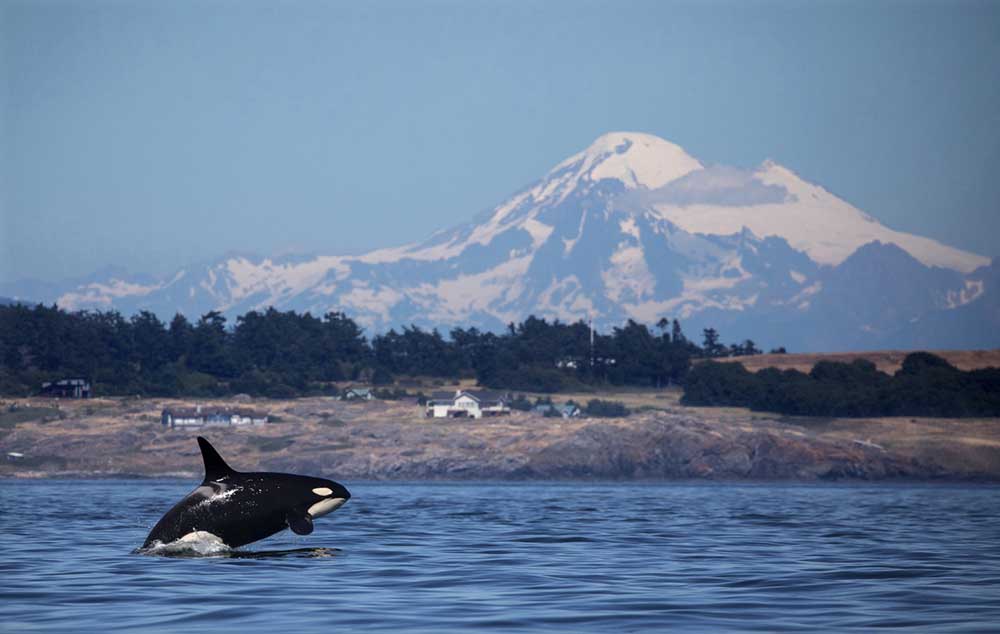Vancouver tourists on ferry gasp as killer whale family glides silently by
Published 7:30 am Tuesday, November 26, 2024

- In this June 2018 photo, a southern resident killer whale breaches in Haro Strait just off San Juan Island's west side with Mount Baker in the background.
A family of killer whales were spotted swimming in the waters of downtown Vancouver, British Columbia, stunning passengers aboard a tourist ferry.
Video shared on social media by False Creek Ferries of the Sunday incident shows four transient killer whales — also known as Bigg’s killer whales — cruising past high-rise buildings, within 10 feet of the ferry. The pod can be seen quietly gliding through the waters, not making a splash.
“They’re so cute; they’re my favorite animal,” one passenger can be heard saying.
“It was pretty surreal,” Jack Hemsworth, captain of the ferry that was crossing from the West End in Vancouver to Kitsilano Beach, told local broadcaster CityNews. “I just had to put the boat into neutral, and just kind of coast right in front of them.”
The 26-year-old mother killer whale, known to experts as T35A or Lester, is one of more than 300 individual killer whales catalogued by Canada’s Department of Fisheries and Oceans. She was spotted with her three calves, in False Creek, just off the popular Sunset Beach.
“You’re not really near animals that large all the time and be able to talk about it,” Hemsworth said. “It was pretty crazy to see how big they really are, because they were bigger than the boat.” Transient killer whales can grow up to 26 feet long.
It’s not the first time the ferry captain has had a close encounter with the majestic creatures; back in 2019, his boat came near to a pod in almost the same spot.
According to professor Volker Deecke, a wildlife conservation professor at the University of Cumbria in Britain, one or two annual general sightings of the population is common in this area of Vancouver.
“In a way, they’ve always lived there, so we shouldn’t be surprised that they’re reclaiming their old hunting grounds,” Deecke said in a phone interview Tuesday.
But it’s not common for humans to see them there — and even rarer for them to be caught on camera, as transient killer whales are stealth hunters, experts say. Deecke believes the killer whales in the video were hunting for prey, most likely harbor seals.
While resident killer whales that live in the North Pacific Ocean can be vocal as they hunt for salmon, mammal-hunting transient killer whales like the ones seen in this video coordinate quiet ambushes by sneaking up on their prey, Deecke said. They typically go underwater for 10- to 15-minute dives and only pop up for air.
“If you don’t look for them, you won’t see them,” he said.
All killer whale populations are protected under the Marine Mammal Protection Act, but can face threats including commercial hunting, culling, habitat loss and food limitations.
To Deecke, sightings of transient whales in False Creek is a sign that the ecosystem is recovering and the harbor seal population is rebounding in the area.
“It’s encouraging to see that they’re comfortable going into these waters,” he said, referring to the killer whales.
Over the past five years, hundreds of boat-ramming incidents have cast killer whales as ocean villains. Since 2020, Iberian killer whale populations off the coast of Spain, Portugal and Morocco have rammed into at least 673 vessels, The Washington Post previously reported. But experts have released a report outlining their hypothesis that the ramming — and often sinking — of the boats is simply juvenile whales treating boat rudders as a toy and playing games.
“People have lived around transient killer whales for centuries and millennia. They’re not going to mistake humans or boats for prey,” said Deecke.
The False Creek ferry, if anything, was probably just in the way, or used by the pod to mask their own sounds while hunting for their prey. “Don’t approach them. Treat them like you would a black bear or a grizzly bear: Give them their space and treat them with respect,” he said.








